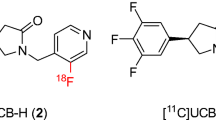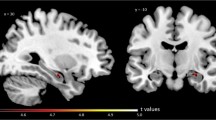Abstract
Purpose
Synapse loss is a hallmark of Alzheimer’s disease (AD) and correlates with cognitive decline. The validation of a noninvasive in vivo imaging approach to quantify synapse would greatly facilitate our understanding of AD pathogenesis and assist drug developments for AD. As animal models of neurodegenerative and neuropsychiatric disorders play a critical role in the drug discovery and development process, a robust, objective, and translational method for quantifying therapeutic drug efficacy in animal models will facilitate the drug development process. In this study, we tested the quantification reliability of the SV2A PET tracer, [18F]SynVesT-1, in a mouse model of AD (APP/PS1) and wild-type controls, and developed a simplified quantification method to facilitate large cohort preclinical imaging studies.
Procedures
We generated nondisplaceable binding potential (BPND) and distribution volume ratio (DVR) values using the simplified reference tissue model (SRTM) on the 90-min dynamic PET imaging data, with brain stem and cerebellum as the reference region, respectively. Then, we correlated the standardized uptake value ratio (SUVR)-1 and SUVR averaged from different imaging windows with BPND and DVR, using brain stem and cerebellum as the reference region, respectively. We performed homologous competitive binding assay and autoradiographic saturation binding assay using [18F]SynVesT-1 to calculate the Bmax and Kd.
Results
Using brain stem as the reference region, the averaged SUVR-1 from 30 to 60 min postinjection correlated well with the BPND calculated using SRTM. Using cerebellum as the reference region, the averaged SUVR from 30 to 60 min postinjection correlated well with the SRTM DVR. From the homologous competitive binding assay and autoradiographic saturation binding assay, the calculated the Bmax and Kd were 4.5–18 pmol/mg protein and 9.8–19.6 nM, respectively, for rodent brain tissue.
Conclusions
This simplified SUVR method provides reasonable SV2A measures in APP/PS1 mice and their littermate controls. Our data indicate that, in lieu of a full 90-min dynamic scan, a 30-min static PET scan (from 30 to 60 min postinjection) would be sufficient to provide quantification data on SV2A expression, equivalent to the data generated from kinetic modeling. The methods developed here are readily applicable to the evaluation of therapeutic effects of novel drugs in this rodent model using [18F]SynVesT-1 and small animal PET.





Similar content being viewed by others
References
Bajjalieh SM, Frantz GD, Weimann JM, McConnell SK, Scheller RH (1994) Differential expression of synaptic vesicle protein 2 (SV2) isoforms. J Neurosci 14:5223–5235
Cai Z, Li S, Matuskey D, Nabulsi N, Huang Y (2019) PET imaging of synaptic density: A new tool for investigation of neuropsychiatric diseases. Neuroscience Letters 691:44–50
Holmes SE, Scheinost D, Finnema SJ, Naganawa M, Davis MT, DellaGioia N, Nabulsi N, Matuskey D, Angarita GA, Pietrzak RH, Duman RS, Sanacora G, Krystal JH, Carson RE, Esterlis I (2019) Lower synaptic density is associated with depression severity and network alterations. Nat Commun 10:1529
Finnema SJ, Nabulsi NB, Eid T et al (2016) Imaging synaptic density in the living human brain. Sci Transl Med 8:348ra396
Onwordi EC, Halff EF, Whitehurst T, Mansur A, Cotel MC, Wells L, Creeney H, Bonsall D, Rogdaki M, Shatalina E, Reis Marques T, Rabiner EA, Gunn RN, Natesan S, Vernon AC, Howes OD (2020) Synaptic density marker SV2A is reduced in schizophrenia patients and unaffected by antipsychotics in rats. Nat Commun 11:246
Matuskey D, Tinaz S, Wilcox KC, Naganawa M, Toyonaga T, Dias M, Henry S, Pittman B, Ropchan J, Nabulsi N, Suridjan I, Comley RA, Huang Y, Finnema SJ, Carson RE (2020) Synaptic changes in Parkinson disease assessed with in vivo imaging. Ann Neurol 87:329–338
Nabulsi NB, Mercier J, Holden D, Carre S, Najafzadeh S, Vandergeten MC, Lin SF, Deo A, Price N, Wood M, Lara-Jaime T, Montel F, Laruelle M, Carson RE, Hannestad J, Huang Y (2016) Synthesis and preclinical evaluation of 11C-UCB-J as a PET tracer for imaging the synaptic vesicle glycoprotein 2A in the brain. J Nucl Med 57:777–784
Mecca AP, Chen M-K, O'Dell RS, Naganawa M, Toyonaga T, Godek TA, Harris JE, Bartlett HH, Zhao W, Nabulsi NB, Wyk BCV, Varma P, Arnsten AFT, Huang Y, Carson RE, Dyck CH (2020) In vivo measurement of widespread synaptic loss in Alzheimer's disease with SV2A PET. Alzheimer’s & Dementia 16:974–982
Chen M-K, Mecca AP, Naganawa M, Finnema SJ, Toyonaga T, Lin SF, Najafzadeh S, Ropchan J, Lu Y, McDonald JW, Michalak HR, Nabulsi NB, Arnsten AFT, Huang Y, Carson RE, van Dyck CH (2018) Assessing synaptic density in Alzheimer disease with synaptic vesicle glycoprotein 2A positron emission tomographic imaging. JAMA Neurology 75:1215–1224
Toyonaga T, Smith LM, Finnema SJ, Gallezot JD, Naganawa M, Bini J, Mulnix T, Cai Z, Ropchan J, Huang Y, Strittmatter SM, Carson RE (2019) In vivo synaptic density imaging with 11C-UCB-J detects treatment effects of saracatinib in a mouse model of Alzheimer disease. J Nucl Med 60:1780–1786
Cai Z, Li S, Zhang W, Pracitto R, Wu X, Baum E, Finnema SJ, Holden D, Toyonaga T, Lin SF, Lindemann M, Shirali A, Labaree DC, Ropchan J, Nabulsi N, Carson RE, Huang Y (2020) Synthesis and preclinical evaluation of an (18)F-labeled synaptic vesicle glycoprotein 2A PET imaging probe: [(18)F]SynVesT-2. ACS Chem Neurosci 11:592–603
Li S, Cai Z, Wu X, Holden D, Pracitto R, Kapinos M, Gao H, Labaree D, Nabulsi N, Carson RE, Huang Y (2019) Synthesis and in vivo evaluation of a novel PET radiotracer for imaging of synaptic vesicle glycoprotein 2A (SV2A) in nonhuman primates. ACS Chem Neurosci 10:1544–1554
Naganawa M, Li S, Nabulsi NB, Henry S, Zheng MQ, Pracitto R, Cai Z, Gao H, Kapinos M, Labaree D, Matuskey D, Huang Y, Carson RE (2020) First-in-human evaluation of 18F-SynVesT-1, a novel radioligand for PET imaging of synaptic vesicle protein 2A. J Nucl Med. https://doi.org/10.2967/jnumed.120.249144
Jankowsky JL, Fadale DJ, Anderson J et al (2003) Mutant presenilins specifically elevate the levels of the 42 residue β-amyloid peptide in vivo: evidence for augmentation of a 42-specific γ secretase. Human Molecular Genetics 13:159–170
Gimbel DA, Nygaard HB, Coffey EE, Gunther EC, Lauren J, Gimbel ZA, Strittmatter SM (2010) Memory impairment in transgenic Alzheimer mice requires cellular prion protein. J Neurosci 30:6367–6374
Um JW, Nygaard HB, Heiss JK, Kostylev MA, Stagi M, Vortmeyer A, Wisniewski T, Gunther EC, Strittmatter SM (2012) Alzheimer amyloid-β oligomer bound to post-synaptic prion protein activates Fyn to impair neurons. Nature Neuroscience 15:1227–1235
Um Ji W, Kaufman Adam C, Kostylev M et al (2013) Metabotropic glutamate receptor 5 is a coreceptor for Alzheimer Aβ oligomer bound to cellular prion protein. Neuron 80:531
Lammertsma AA, Hume SP (1996) Simplified reference tissue model for PET receptor studies. Neuroimage 4:153–158
Logan J, Fowler JS, Volkow ND, Wang GJ, Ding YS, Alexoff DL (1996) Distribution volume ratios without blood sampling from graphical analysis of PET data. J Cereb Blood Flow Metab 16:834–840
Kaminski RM, Gillard M, Leclercq K, Hanon E, Lorent G, Dassesse D, Matagne A, Klitgaard H (2009) Proepileptic phenotype of SV2A-deficient mice is associated with reduced anticonvulsant efficacy of levetiracetam. Epilepsia 50:1729–1740
Gillard M, Fuks B, Leclercq K, Matagne A (2011) Binding characteristics of brivaracetam, a selective, high affinity SV2A ligand in rat, mouse and human brain: relationship to anti-convulsant properties. Eur J Pharmacol 664:36–44
Patel S, Knight A, Krause S et al (2019) Preclinical in vitro and in vivo characterization of synaptic vesicle 2A-Targeting compounds amenable to F-18 labeling as potential pet radioligands for imaging of synapse integrity. Mol Imaging Biol. 22:832–841
Lynch BA, Lambeng N, Nocka K, Kensel-Hammes P, Bajjalieh SM, Matagne A, Fuks B (2004) The synaptic vesicle protein SV2A is the binding site for the antiepileptic drug levetiracetam. Proc Natl Acad Sci USA 101:9861–9866
Mercier J, Archen L, Bollu V, Carré S, Evrard Y, Jnoff E, Kenda B, Lallemand B, Michel P, Montel F, Moureau F, Price N, Quesnel Y, Sauvage X, Valade A, Provins L (2014) Discovery of heterocyclic nonacetamide synaptic vesicle protein 2A (SV2A) ligands with single-digit nanomolar potency: opening avenues towards the first SV2A positron emission tomography (PET) ligands. ChemMedChem 9:693–698
Estrada S, Lubberink M, Thibblin A, Sprycha M, Buchanan T, Mestdagh N, Kenda B, Mercier J, Provins L, Gillard M, Tytgat D, Antoni G (2016) [11C]UCB-A, a novel PET tracer for synaptic vesicle protein 2 A. Nucl Med Biol 43:325–332
Warnock GI, Aerts J, Bahri MA, Bretin F, Lemaire C, Giacomelli F, Mievis F, Mestdagh N, Buchanan T, Valade A, Mercier J, Wood M, Gillard M, Seret A, Luxen A, Salmon E, Plenevaux A (2014) Evaluation of 18F-UCB-H as a novel PET tracer for synaptic vesicle protein 2A in the brain. J Nucl Med 55:1336–1341
Hong S, Beja-Glasser VF, Nfonoyim BM, Frouin A, Li S, Ramakrishnan S, Merry KM, Shi Q, Rosenthal A, Barres BA, Lemere CA, Selkoe DJ, Stevens B (2016) Complement and microglia mediate early synapse loss in Alzheimer mouse models. Science 352:712–716
Pozueta J, Lefort R, Shelanski ML (2013) Synaptic changes in Alzheimer’s disease and its models. Neuroscience 251:51–65
Bertoglio D, Verhaeghe J, Miranda A, et al. (2019) Validation and noninvasive kinetic modeling of [(11)C]UCB-J PET imaging in mice. J Cereb Blood Flow Metab 0:271678X19864081.
Naganawa M, Gallezot J-D, Finnema S, Matuskey D, Mecca AP, Nabulsi NB, Labaree D, Ropchan J, Malison RT, D'Souza DC, Esterlis I, Detyniecki K, van Dyck CH, Huang Y, Carson RE (2020) Simplified quantification of 11C-UCB-J PET evaluated in a large human cohort. J Nucl Med. https://doi.org/10.2967/jnumed.120.243949
Cai Z, Li S, Zhang W et al (2020) Synthesis and preclinical evaluation of an 18F-labeled synaptic vesicle glycoprotein 2A PET imaging probe: [18F]SynVesT-2. ACS Chem Neurosci 11(4):592–603
Li S, Cai Z, Zhang W, Holden D, Lin SF, Finnema SJ, Shirali A, Ropchan J, Carre S, Mercier J, Carson RE, Nabulsi N, Huang Y (2019) Synthesis and in vivo evaluation of [(18)F]UCB-J for PET imaging of synaptic vesicle glycoprotein 2A (SV2A). Eur J Nucl Med Mol Imaging 46:1952–1965
Rossano S, Toyonaga T, Finnema SJ et al (2019) Assessment of a white matter reference region for (11)C-UCB-J PET quantification. J Cereb Blood Flow Metab 40:1890–1901
Acknowledgments
The authors would like to acknowledge the Yale PET Center staff for their expert technical assistance. The authors thank Ivailo Mihaylov and Anthony D’Abramo Jr for their assistance with autoradiography study.
Funding
This research was supported by National Institutes of Health (NIH) K01EB023312, R01AG058773, R01AG052560. Z.C. is an Archer Foundation Research Scientist.
Author information
Corresponding author
Ethics declarations
Conflict of Interest
The authors declare that they have no conflict of interest.
Ethical Approval
All procedures performed in studies involving animals were in accordance with ethical standards of the Yale University Institutional Animal Care and Use Committee.
Additional information
Publisher’s Note
Springer Nature remains neutral with regard to jurisdictional claims in published maps and institutional affiliations.
Supplementary Information
ESM 1
(DOCX 1193 kb)
Rights and permissions
About this article
Cite this article
Sadasivam, P., Fang, X.T., Toyonaga, T. et al. Quantification of SV2A Binding in Rodent Brain Using [18F]SynVesT-1 and PET Imaging. Mol Imaging Biol 23, 372–381 (2021). https://doi.org/10.1007/s11307-020-01567-9
Received:
Revised:
Accepted:
Published:
Issue Date:
DOI: https://doi.org/10.1007/s11307-020-01567-9




